Audio Visual Bend Blog
Green AV

Photo and Graphic Design By: Kate Couch
Across The Globe
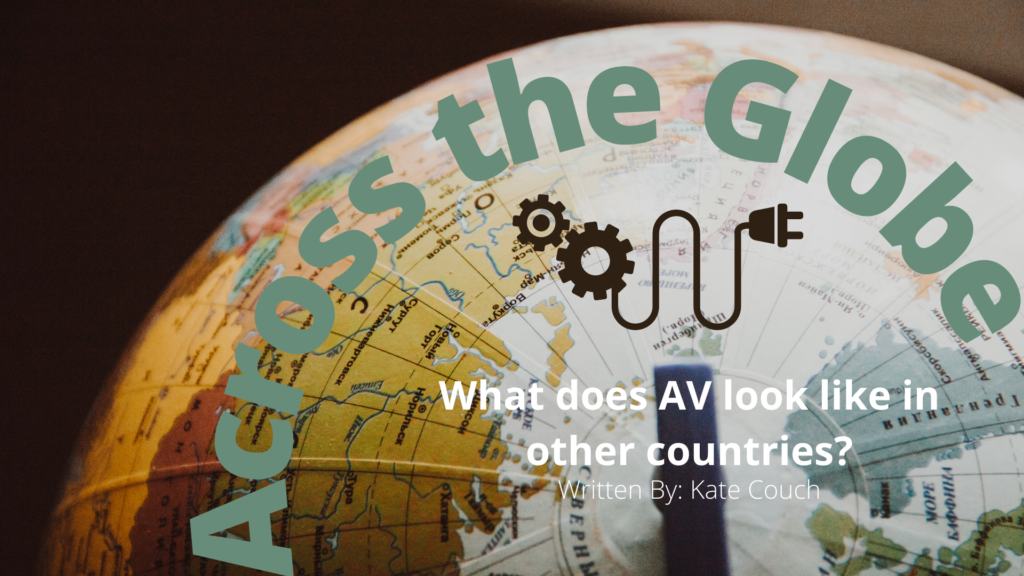
Image and Graphic Design By: Kate Couch with Canva
What does AV look like in other developed countries?
Written By: Kate Couch for AV Bend
It’s very easy to forget how much of the amenities and services we have in the US are available in other countries. Just because they speak a different language than us or have different customs doesn’t mean they’re not using the same computer. In fact, in 2019 Apple sales went up 2% in Europe according to Apple Insider. So what does this mean for AV in other countries?
AV was recently impacted in 2020 when the pandemic hit. This created a need for AV at home and for “Zoom Rooms” in corporate offices. Not every country was prepared to send their employees home due to lack of technology and wifi. Harvard Business Review designed a graph (see below) displaying the readiness of each country. Countries like Norway, the Netherlands, Estonia, and the UK scored high. These countries are highly developed technology-wise and use most of the same technology we use here in the US. Unfortunately, countries like Mexico, Chile, India, and South Africa scored low. Their ability to conform technologically was hindered due to their economic status and because of that, it hit their citizens harder.
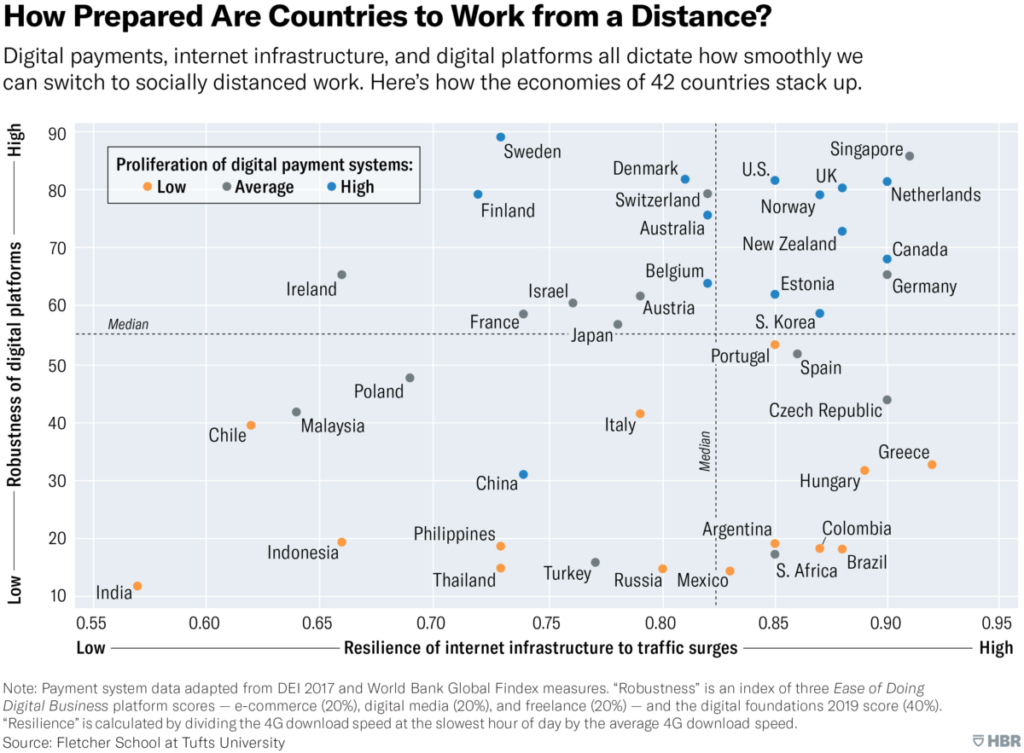
Image from Harvard Business Review
The goal is to make these second-world countries more up-to-date when it comes to AV and technology. Companies like the World Intellectual Property Organization (WIPO) are doing studies to raise awareness of this need. Before the pandemic hit in August 2018, WIPO did a study on Africa’s need for audiovisual equipment. It specifically highlights how this would increase the accuracy of economic data collection. Their study was intended to “highlight the importance of gathering audiovisual market data to achieve tangible results in developing effective policies, including for the acquisition, management and use of intellectual property (IP) rights, to strengthen the audiovisual sector in five African countries (Burkina Faso, Côte d’Ivoire, Kenya, Morocco, and Senegal).” Read the full article here. Organizations and studies like these make it possible for second-world countries to become more integrative with recent audiovisual advancements.
Even though other countries in Europe use different outlets than we use here in the US, there isn’t much difference in their audiovisual setups or how they use their technology. This is mainly because they are as economically advanced as the US. Economics plays a huge role in which technology and audiovisual setups are incorporated into the government and into citizens’ daily lives. When it comes to providers and distributors there are slight differences. The European AV Group is a company whose goal is to “Become the most trusted supplier of professional Audio, Video and Control products across Europe,” according to their website. We don’t have this in the US (we have the unaffiliated USAV group which provides similar services) but the content they use and the products they sell are either the same or comparable to those in the US.
Accessibility associated with economics has more to do with the differences in audiovisual than cultural differences. Developed countries model the US in technology and AV very closely. This is important as businesses expand on an employee and customer basis across the globe.
*This article is by Tony Sprando of AV Bend’s intellectual property. To use or reference this article please contact: Tony@avbend.com*
To know more about Tony and his professional profile see these:
https://www.linkedin.com/in/tonysprando/
https://www.ravepubs.com/author/tsprando/
To know more about Kate and her professional profile see these:
https://www.linkedin.com/in/kate-couch-a7318220a/
https://k8couch.wixsite.com/katecouch
USB Headaches
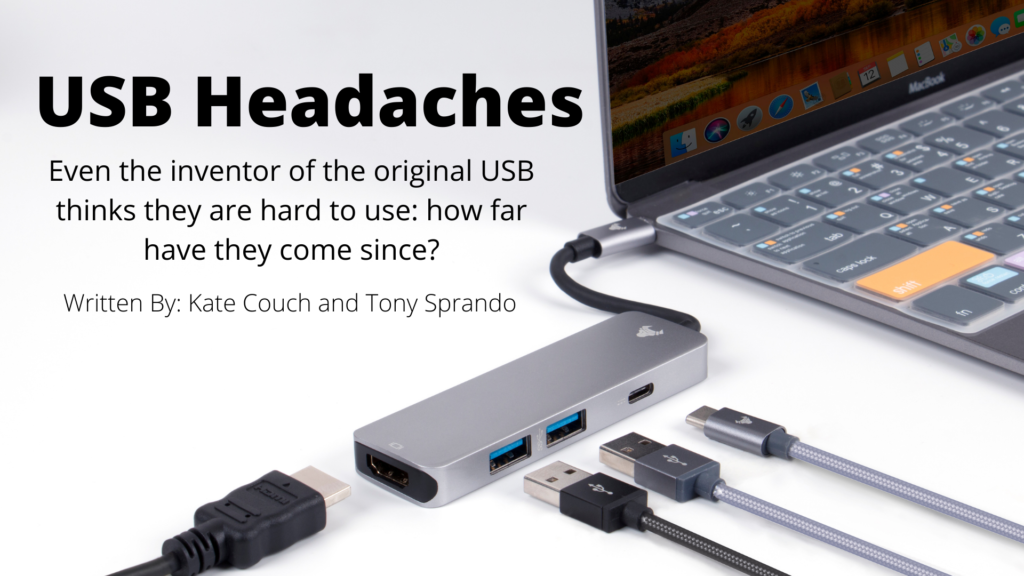
Photo and Graphic Design By: Kate Couch
Even the inventor of the original USB thinks they’re hard to use: how far has USB come since?
Written By: Kate Couch and Tony Sprando
In 2019 Fox News reported the following “Ajay Bhatt, who led the Intel team that created the Universal Serial Bus, told NPR the design of USB ports used to plug in devices such as keyboards, mice, printers and thumb drives is a bit annoying. Frustrated users have created several memes over the years mocking USB devices.” in this article.
It is quite humerus and humble of Bhatt to come out and say this to the world who uses his invention daily. He is referring to the design of the USB which can only be plugged in one way. However, since Bhatt invent the first USB we have come up with faster and newer models.
After the first USB (1.1) was the USB 2.0 which came out in the year 2000. USB 2.0 delivers a maximum transfer speed of 480 Megabits per second compared to the 12 Mbps (megabytes per second) of the original 1.1 USB. 10 years later the USB 3.0 came out. The USB 3.0 was a drastic step up. It delivers 640 Mbps and is 10 times faster. With these improvements, the ability of the USB and USB ports expanded.
The reason why this continuous improvement with extended bandwidth in the USB timeline is so significant is that with every improvement made, the USB can support more technology. The USB 3.0 is the business-class video conferencing standard. USB 3.0 is needed to pass 4k video camera content/webcams, ptz cams, etc. Originally USB could only support low-bandwidth devices like keyboards mouses and printers but now USB can support things like 4K video, excessive amounts of storage, as well as laptop and device charging.
In 2014 USB-C came out. It too was a much faster improvement at 10Gbps which is on the scale of the billions where Mbps is on the scale of the millions. USB 3.0 has a capacity of 5 Gbps making the USB-C twice the speed as its predecessor. The most remarkable thing about the USB-C is that it is reversible. This fixes the 20-year problem of the non-reversible USB that has been long made fun of. It really is ironic that it took us 20 years to fix such an obvious problem but luckily those are all problems of the past! Both the USB 3.0 and the USB-C are used in today’s technology as they are both high bandwidth supporting and extremely fast.
The interesting thing about technology is that even though the USB-C is the freshest thing out there right now in less than five years we will probably have something new and wouldn’t even be able to imagine using the USB-C. The audio-visual world is constantly changing and keeping up with it isn’t always easy. The important thing to keep in mind is to constantly be checking in for new trends and tech; on pages like this or other sites from around the web.
Thanks For Reading!
*This article is Tony Sprando of AV Bends intellectual property. To use or reference this article please contact: Tony@avbend.com*
To know more about Tony and his professional profile see these:
https://www.linkedin.com/in/tonysprando/
https://www.ravepubs.com/author/tsprando/
To know more about Kate and her professional profile see these:
https://www.linkedin.com/in/kate-couch-a7318220a/
https://k8couch.wixsite.com/katecouch
Heath and wellness a bigger concern and fast-growing industry.

Photo and Graphic Design By: Kate Couch
Health and wellness is a booming industry but does it involve audio and visual?
Written By: Kate Couch
The health and wellness industry is a much bigger industry than most people realize. In fact, according to the Global Wellness Institute, the wellness economy is currently valued at 4.5 trillion dollars and represents 5.3% of global economic output. Because of Covid-19 companies are forced to be hyper-aware of how they are dealing with their employee’s and customers’ health. But how does audio-visual come into this? The biggest impact audio-visual has made in the health and wellness movement is on the corporate division: outdoor audio-visual setups. From the medical side, AV systems in hospital rooms and patient rooms.
Outdoor AV Setups
If following Covid guidelines gathering spaces have maximum capacities, however, that maximum capacity increases when the event is held outside. In addition to this when held outside, people usually don’t have to wear masks. Corporate companies and small businesses have been opting for more outside-oriented gathering places for customers and employees. This created the need for weatherproof audio-visual technology set-ups. Having large outdoor AV setups is something that’s now in high demand similar to the zoom rooms, which were in high demand last year. Large sturdy weatherproof monitors and screens paired with wind-resistant microphones and speakers all help created a better outdoor meeting place.
Heath AV
In addition to the corporate side of health and wellness AV, there’s also personal health and wellness AV. At-home gyms with AV setups for live streaming exercise classes are something you see in more homes now. Exercise equipment, like the Peloton that has a large display screen, has also made an impact on the market. Technology and audio-visual are integrating themselves into every industry and health and wellness are no exception.
Primary care AV
AV in the last 5 years has made an impact on patient care in hospitals and nursing homes. This is probably one of the bigger impacts that AV has made on the health and wellness industry. Remote patient monitoring is a monitoring setup system in a patient’s room. Nurses and doctors can check up on patients without having to be in their rooms 24/7. Remote patient monitoring has decreased dangerous patient falls by 17.3% according to Building and Environment written by, E. Morales. Telehealth is also something that hospitals and primary care providers have implemented. This includes virtual doctors’ appointments, therapy sessions, or interpersonal meetings between doctors. These have to be done through a very secure and safe system for patients’ privacy. The proper audio-visual setup for these circumstances in hospitals and doctors’ offices is crucial.
Hospitals have also been including other AV systems in their clinics, such as sound masking for auditory privacy. Technology integrated rooms with patient’s vitals being sent to AVscreens and hubs that are easier for everyone to access.
The health and wellness industry is growing rapidly, it’s something that’s becoming more important to people and business. Audio-visual can be a big help in making sure that your employees and communities stay safe and healthy while adapting to the needs of new technology. If you’re interested in any of these systems reach out to a local audio-visual professional like Audio Visual Bend.
*This article is Tony Sprando of AV Bends intellectual property. To use or reference this article please contact: Tony@avbend.com*
To know more about Tony and his professional profile see these:
https://www.linkedin.com/in/tonysprando/
https://www.ravepubs.com/author/tsprando/
To know more about Kate and her professional profile see these:
https://www.linkedin.com/in/kate-couch-a7318220a/
https://k8couch.wixsite.com/katecouch
Heard and not seen
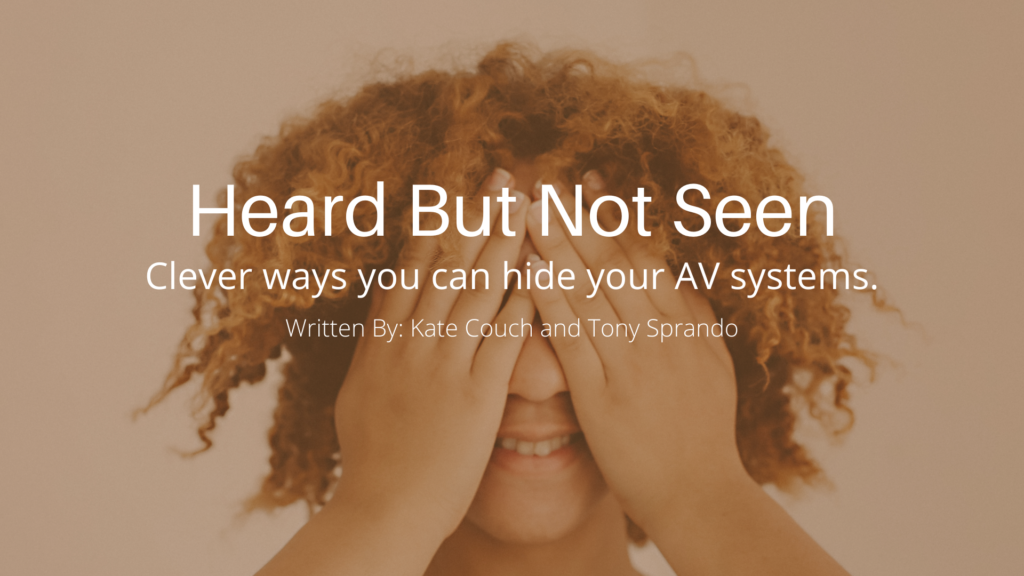
Photo and Graphics by: Kate Couch with Canva
Better well done than well said

Photo By: Kate Couch with Canva
Time Will Not
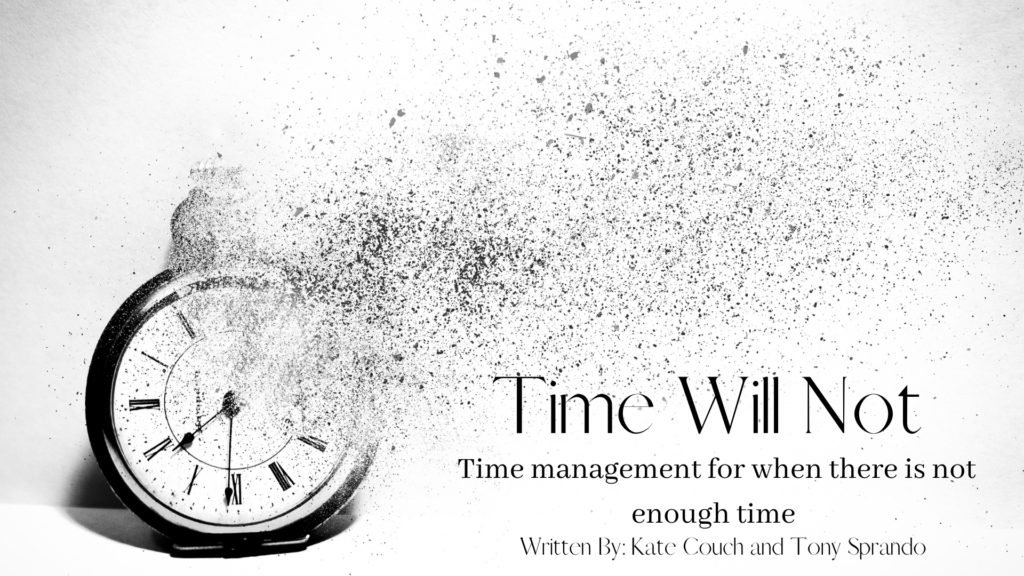
Photo By: Kate Couch with Canva
Where customers fall down
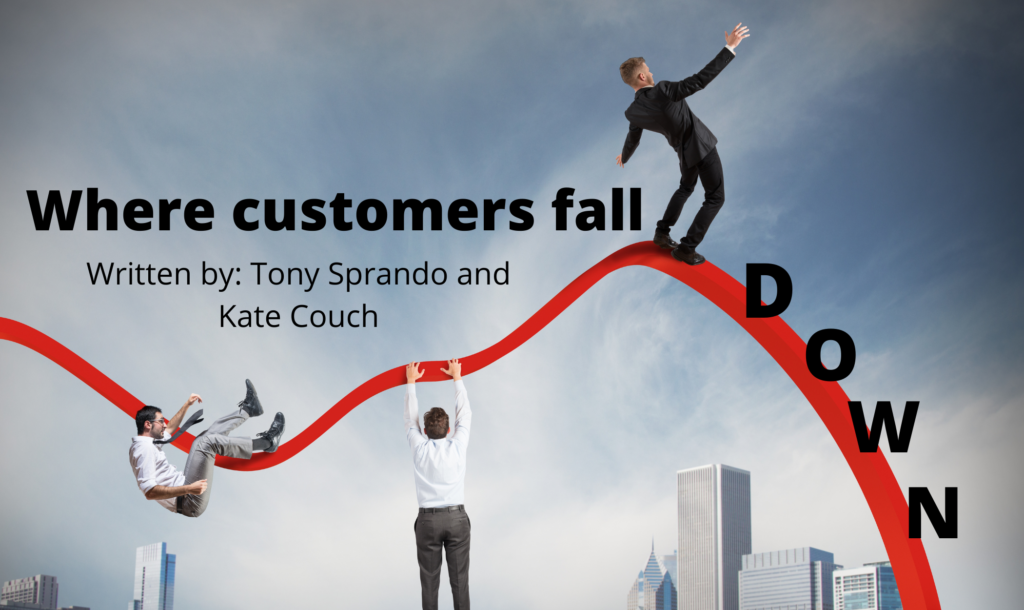
Photo by: Kate Couch with Canva
Written By: Tony Sprando and Kate Couch
What we believe and what we feel about a situation has strong ties. This usually circulates around the value we put on something. Like when you reach for that apple in the grocery store, you hesitate and hover for a moment to grab the one that looks the best… without knowing where it was grown, what care was taken to get it there, and how it was carefully or handled by the grocery clerk. You are putting a certain amount of trust in that purchase, oftentimes based on how you were treated at the door. You buy based on what you need, price, influencing of marketing and item placement, and personal assessment of the item. When you think about it we put a lot of thought into these things subconsciously.
When it comes to something much more expensive, there is a higher level of feeling and assumption involved… or not. Over the past 20 years, I’ve done many audiovisual jobs. But for as many jobs I’ve done I’ve also calculated twice as many bids. end as somebody who works delivering a service you notice a pattern when giving a bid. You will find that when you go out and you assess what client needs, finding them the right services for a fair price, for some people it’s never enough. Oftentimes no matter how much you try to give some a deal, or explain why something is costly they will not think it is cheap enough.
Where customers “fall down” starts as a client drilling the service provider to get the price down possibly to please a boss or to make them feel better about the service. Another example is leaning into friends, family, or a church friend for a deal. We might do this because “in the name of making an eternal difference” may guilt them into giving you a good deal, or believing that God demands we are “frugal” and we can’t have nice things because “the humble will inherit the earth” … a bible verse that is so often taken out of context.
Lastly, we can go wrong by blindly going with the lowest bid and trusting the provider that they know what they are doing, this would be coined as the belief in poverty theology. This is a trap many frugal people fall into. Unfortunately doing something cheap isn’t always doing something right. When you go with the cheapest option then find out that it’s not working properly after. I find that they patch the problems with their audiovisual system and suffer through it until… eventually calling out for help to rescue them from a subpar system installation. Unfortunately at this point, the price tag is usually much higher. It’s a well-known fact that it is easier to build something new than try to salvage or demo an existing audiovisual system.
In all my years of AV, I have seen a much higher success rate in investing in people and not worrying as much about the money. Set the profit you need to run a business, then stand tall as you hand over the bid or proposal… and if the customer does his or her due diligence then they will find an Audiovisual integrator that is highly spoken of and then just spends the money once. Though your job may cost a bit more than you may have thought, your actions will give the AV group confidence that they are not being squeezed. This will allow them to work freely, giving you a quality system you can stand up to with confidence.
All that being said this doesn’t mean a job can’t be cost-efficient. We always want to work with our clients to find a cost-efficient solution for them that gets their goals completed and that will last. Quality over quantity, vice-versa, is an age-old debate and each one has its time and place. But I will settle it for AV, when you build a quality AV system using a reliable service provider, you will be happy with results that will stand the test of time and meet your needs: the first time.
*This article is Tony Sprando of AV Bends intellectual property. To use or reference this article please contact: Tony@avbend.com*
To know more about Tony and his professional profile see these:
https://www.linkedin.com/in/tonysprando/
https://www.ravepubs.com/author/tsprando/
To know more about Kate and her professional profile see these:
https://www.linkedin.com/in/kate-couch-a7318220a/
https://k8couch.wixsite.com/katecouch
Sound and Noice Control in Steel Frame Buildings
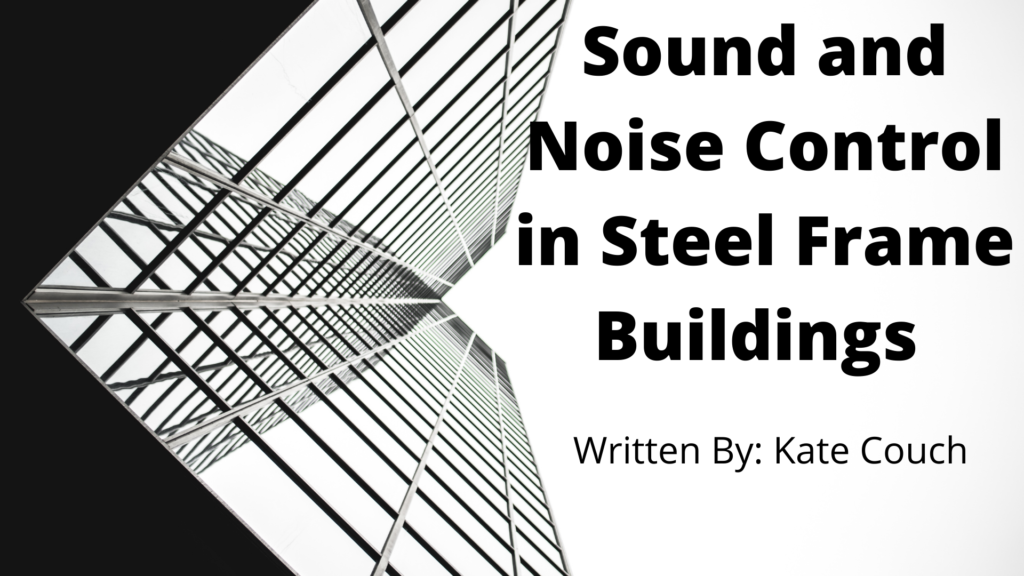
Photo and graphics by Kate Couch with Canva
Written By: Kate Couch with inspiration from American Institute of Steel construction’s article: Sound and Noise Control in Steel Frame Buildings.
At AV Bend we deal with a lot of commercial customers. People trying to design sound solutions for their commercial space. But one thing in AV that frequently flies under the radar is sound isolation in steel-frame and metal buildings. With more corporate offices being built similar to homes the industrial-type buildings are left by the wayside. But they still exist and lots of them still need proper acoustical treatment. So that poses the question: how do you treat a mental space? Ironically enough that question isn’t just for Audio Visual. Owner of AV Bend Tony Sprando has a son who owns a 1981 VW Rabbit, which until the other day was extremely loud. After some thought, they decided to line the interior with, Dynamat 11102 Dynaliner a thick self-adhesive sound deadener. This reduced the noise of the car by over 50% and was a simple and cheap fix for the sound metal problem. The fact that metal is such a loud material realy can affect multiple different areas.
Sound and noise control with metal and steel frame buildings begins in architecture. When an architect is designing these buildings (which frequently are schools warehouses and studios) they take certain design styles into account when using these materials. Taking the principle of acoustic comfort, which is what materials a designer uses, they will combine the louder more reflective materials such as metal with more sound-absorbent ones like wood. The sound absorbency of a material is referred to as its sound transmission class. This reduces how much sound is bouncing off of the walls. In some cases, something called flanking transmission happens when sound travels through walls and ceilings. So in addition to adding more of those materials that absorb sound, they also tend to make thicker walls with heavier-set insulation which decreases the sound travel or flanking transmission from room to room. Stud size and spacing, as well as the thickness of the walls, will all determine how much sound blockage and absorption there is. The more layers in a wall the less sound travel.
How sound travels is a science and this is something that architects also have to keep in mind. In addition to what materials they use and how much materials they use, how they placed these materials in the design of the building will also heavily affect sound travel. Architects that are dealing with louder materials like metal will frequently design a more acoustically quiet architectural design. Placing walls and ceilings strategically so the sound travels in a quieter way. But in order to completely do an architectural acoustical treatment, you need to take both materials and design into account. For example, how you place the walls and ceilings can dampen the sound of traveling voices but not hard sole shoes on tile metal or wood floors. Shoes can really drive up the decibel count of space. This is called Impact Insulation Class or IIC. This is why it’s important to also consider the materials used. Adding things like carpet the hallways that may need to be quieter.
After the architect designs a building with noise control and acoustical treatment in mind then a company like AV Bend comes in. This is when the decoration design and additional things we can add to the building come in hand. If things like wall thickness and materials didn’t do the job we can then take our acoustical treatment plans that we use for other commercial spaces into metal frame buildings. We also consider what is happening in the room. Taking into account the frequency of those sounds to design something custom. Adding foam wall panels considering certain types of furniture and its placement. All the way down to what is hung on the walls and where a local AV company we’ll take the design of the building and treat it for its specific noise issues.
If you have a metal-framed building for your corporate office consider using a local company like AV Bend to treat your sound issues.
*This article is Tony Sprando of AV Bends intellectual property. To use or reference this article please contact: Tony@avbend.com*
To know more about Tony and his professional profile see these:
https://www.linkedin.com/in/tonysprando/
https://www.ravepubs.com/author/tsprando/
To know more about Kate and her professional profile see these:
https://www.linkedin.com/in/kate-couch-a7318220a/
https://k8couch.wixsite.com/katecouch
Digital Marketing for your Business in 2021

What is a digital marketing and how to take advantage of it?
Written By: Kate Couch
Digital marketing is a form of online marketing, it usually circulates video and virtual marketing such as video advertisements or video placement on websites. It can also refer to virtual advertisements, gifs, and other animations. Digital marketing in the world of IOT and technology is very prevalent for businesses. In audiovisual we work to present digital marketing for clients and cater to clients who need screens and audio for digital marketing. But as a business, it’s also important to note that digital marketing is something that every business should consider integrating.
There are four main types of digital marketing, pencil drawing animation, character animations, graphic animations, avatar animations. These are all displayed across the internet and other forms of virtual marketing. A lot of these are achieved through apps like Adobe Photoshop, Canva, Procreate, and more. It is graphic design geared towards marketing and oftentimes animated graphic design. But digital marketing can also be purely video and live actors as well. Digital marketing as a whole means how you can mark your product or service using the internet. How can you sell a product using audio-visual? With everyone using the internet 24/7 it’s an easy question. The hard one is: where and how?
One of the main helpers of digital marketing and SEO is Google. Which has a lot of digital marketing plans. The nice thing about the internet of things (IOT) which we talked about in our last article is that it’s all about collecting data. With this data, you can see your customer bases and get their analytics. See what your customers need and what they’re using. You could use this in any form of audio-visual or small business. With this information, you can go even deeper into digital marketing. Once you understand what you need to mark it and who to, is developing digital advertising.
With graphics design apps like Adobe or Canva, you can create ads. If you want to display video digital marketing you could use apps such as Vidivy, Lumen5, or Avairy which helps aid video marketing. You can then use local audiovisual companies (like AV Bend) help to display your video marketing or even help you create it.
It’s important with digital marketing to develop a goal. After you identify what your customers need you can then identify what form of digital marketing you would like to use to reach these customers and why you want to reach them. Then you can come up with an action plan of how you’re going to reach them and what things you are going to do to reach them. It’s also important to identify why you are reaching these people. By using the data from IOT and other analytics like Google you can identify why you are doing this type of marketing to avoid wasting time or money.
The most general form of digital marketing is Media. Media has is been an up-and-coming job title in recent years. Because we are always on our phones media and marketing through media can play a really huge role in your business. Making sure you’re connected to popular social media sites like LinkedIn, Facebook, Instagram, Youtube, Twitter, and Reddit. Will help you market to a younger generation and keep your business streamlined for the future. Below are a few tips that you can follow to help keep up on social media.
- Assign somebody from your team to take photos of projects before and after
- Post frequently frequency reminds customers that you’re around and that you have good communication
- Join groups on social media to stay connected with people that are interested in areas of your business
- Keep it clean and consistent. Consistency is important with social media to properly display your business format. Keep it clean by being picky with where you post making sure it’s only on relevant sites.
- Make sure to invest locally. You can do this through local papers or websites or blogs. When you establish your business as part of the community You build loyalty among it. Integrating locally is extremely important.
Digital marketing is going to become the only form of marketing in the future so the sooner you understand it and start to integrate it into your company the easier the transition will be. These last few years have been very technology-heavy, and the technological advancements that have been made even in the last year are insane. It’s important as a business owner and of clients of audio-visual to understand these changes and hop on the trends so our technology doesn’t start to run us; we run it.
*This article is Tony Sprando of AV Bends intellectual property. To use or reference this article please contact: Tony@avbend.com*
To know more about Tony and his professional profile see these:
https://www.linkedin.com/in/tonysprando/
https://www.ravepubs.com/author/tsprando/
To know more about Kate and her professional profile see these:
https://www.linkedin.com/in/kate-couch-a7318220a/
https://k8couch.wixsite.com/katecouch

